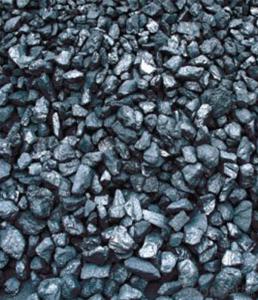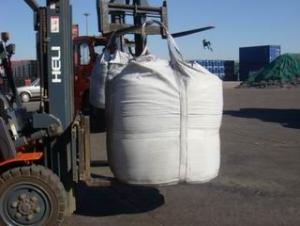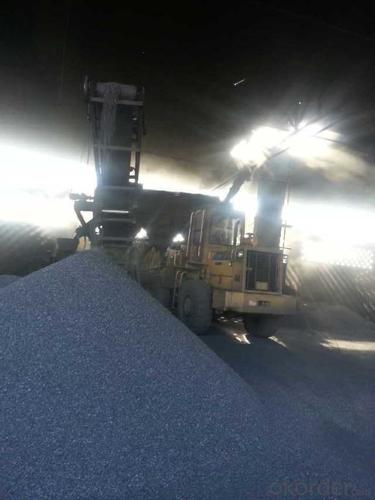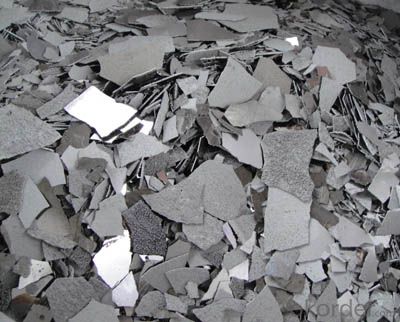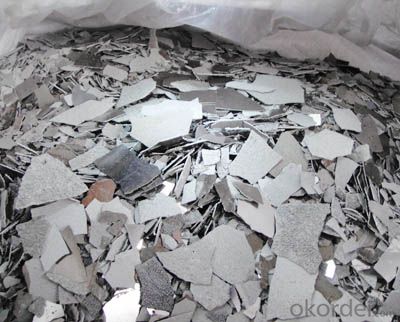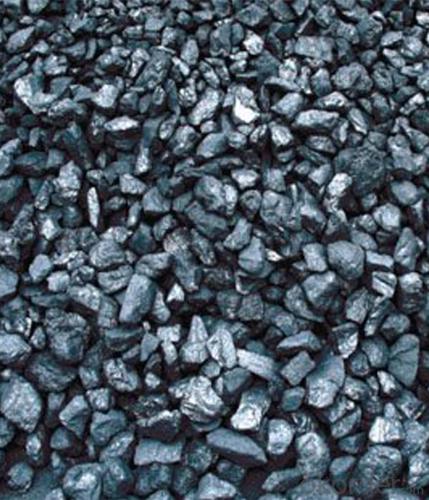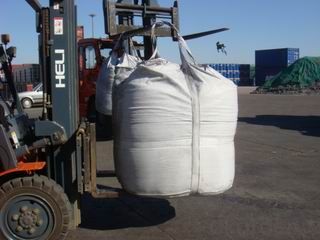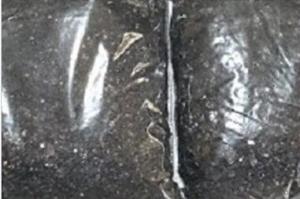FC 93% GAS Calcined Anthracite
- Loading Port:
- China Main Port
- Payment Terms:
- TT or LC
- Min Order Qty:
- -
- Supply Capability:
- -
OKorder Service Pledge
OKorder Financial Service
You Might Also Like
FC 93% GAS Calcined Anthracite
Date Sheet For Your Reference:
F.C | S | ASH | V.M | MOISTURE |
96%MIN | 0.18%MAX | 2.5%MAX | 1.2%MAX | 0.3%MAX |
95%MIN | 0.25%MAX | 4%MAX | 1.2%MAX | 0.5%MAX |
94%MIN | 0.3%MAX | 4.5%MAX | 1.2%MAX | 0.5%MAX |
93%MIN | 0.3%MAX | 5.5%MAX | 1.2%MAX | 0.5%MAX |
92%MIN | 0.3%MAX | 6.5%MAX | 1.2%MAX | 0.5%MAX |
91%MIN | 0.3%MAX | 7.5%MAX | 1.5%MAX | 0.5%MAX |
90%MIN | 0.35%MAX | 8.5%MAX | 1.5%MAX | 0.5%MAX |
Application
1. This product can be used in steel producing as a kind of carbon additive
2. We can get high quality steel if use it.
3. It can also be used in special steel producing and casting or other related industry
4. It can be used as carbon raiser (Recarburizer) to produce high quality steel, cast iron and alloy.
5. It can also be used in plastic and rubber as an additive.
6. Used as carbon raiser (Recarburizer) to produce high quality steel, cast iron and alloy.
7. It can also be used in plastic and rubber as an additive.
Package:
1) 1mt jumbo bag
2) Only25kgs small bags
3) 25kgs*40 in 1mt jumbo bags
4) Size:1-4mm 1-3mm 1-5mm 2-6mm 3-5mm 1-10mm
5) We can produce as customer’s requirement
6) Delivery time:15day against contract
7) Proction Ability:1000mt/month
Why Choose Calcined Anthracite ?
It may substitute massively refinery coke or the stone grinds.
Its cost is much less than the refinery coke and the stone grinds.
Use as the fuel, its calorific value achieve above 9386K/KG. It substitute burnt carbon massively.
Burnt carbon export have quota;so the carbon additive price superiority is similarly obvious.
Pictures of Calcined Anthracite:

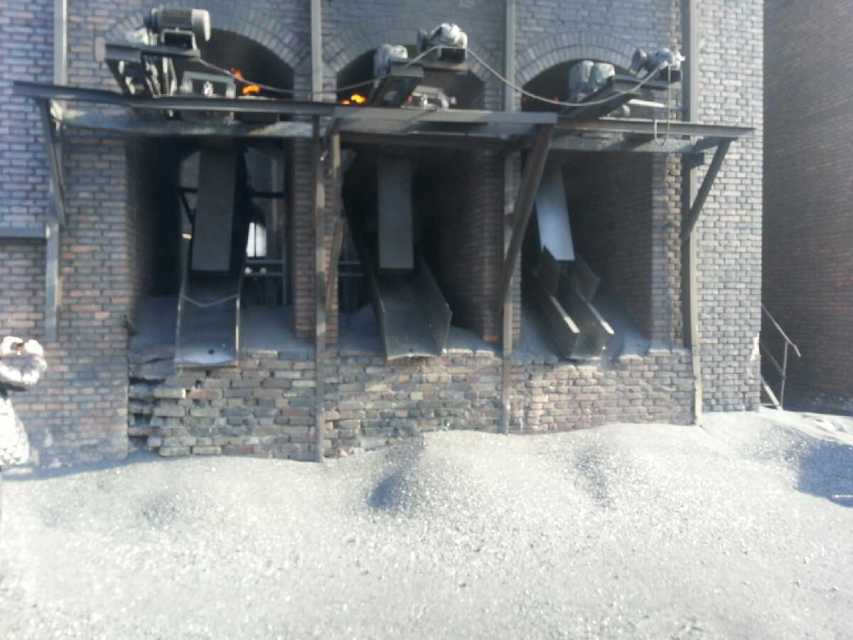
- Q: How does carbon cycle through living organisms?
- Carbon is exchanged and recycled among different parts of the Earth, including living organisms, in a process known as the carbon cycle. Living organisms primarily acquire carbon through photosynthesis, where sunlight, carbon dioxide, and water are used to produce glucose and oxygen. Plants absorb carbon dioxide from the atmosphere and convert it into glucose, which serves as an energy source for their growth. Some glucose is immediately utilized by plants, while the excess is stored as starch and other carbohydrates. This is how carbon is initially incorporated into living organisms. Consumers, such as animals, obtain carbon by consuming plants or other animals that have consumed plants. When animals consume plants, the stored carbohydrates are broken down into glucose, releasing carbon dioxide through cellular respiration. Animals use glucose as an energy source for their own metabolic activities. When animals and plants die or produce waste, their organic matter decomposes, releasing carbon back into the environment. Some of this carbon is converted into carbon dioxide through decomposition and returned to the atmosphere. However, decomposers like bacteria and fungi convert a significant portion of carbon into organic compounds that can be utilized by other living organisms. The carbon cycle continues as carbon is constantly exchanged between the atmosphere, living organisms, and Earth's reservoirs such as the oceans and soil. Carbon can also be stored for extended periods as fossil fuels like coal, oil, and natural gas. When these fuels are burned for energy, carbon dioxide is released into the atmosphere, contributing to the greenhouse effect and climate change. In summary, the carbon cycle is a complex process involving the continuous exchange and transformation of carbon between living organisms and the environment. It is critical for maintaining carbon balance in our ecosystem and plays a significant role in regulating the Earth's climate.
- Q: What is the carbon content of different types of household waste?
- The carbon content of different types of household waste can vary depending on the specific materials being discarded. Generally, organic waste such as food scraps, yard waste, and paper products tend to have a higher carbon content compared to inorganic waste like glass, plastics, and metals. Food waste is primarily composed of organic materials and has a high carbon content. It typically ranges from 50 to 70 percent carbon content. This is because food is derived from plants and animals, which contain carbohydrates, proteins, and fats that are rich in carbon. Yard waste, such as grass clippings, leaves, and branches, also has a substantial carbon content. It contains plant matter that is predominantly made up of cellulose and lignin, which are carbon-based compounds. The carbon content of yard waste can vary depending on the type of vegetation, but it generally falls within the range of 40 to 60 percent. Paper products, such as newspapers, cardboard, and office paper, are primarily made from wood pulp. Wood is composed of cellulose, hemicellulose, and lignin, all of which contain carbon. As a result, paper waste has a significant carbon content, typically ranging from 40 to 60 percent. On the other hand, inorganic waste materials like glass, plastics, and metals have minimal carbon content. These materials are primarily derived from non-renewable resources such as minerals and fossil fuels, which are low in carbon content. Therefore, their carbon content is negligible or close to zero. It is important to note that while organic waste contains higher carbon content, it also has the potential to be composted or converted into biogas through anaerobic digestion, thereby contributing to carbon sequestration or renewable energy generation. In contrast, inorganic waste materials like plastics and metals are non-biodegradable and can have detrimental environmental impacts if not properly managed.
- Q: How are carbon nanotubes used in various applications?
- Carbon nanotubes are used in various applications due to their unique properties. They are used in electronics and semiconductors for their high conductivity, in energy storage devices for their high surface area and lightweight nature, and in medicine for drug delivery and imaging purposes. Additionally, carbon nanotubes find applications in materials science, aerospace engineering, and environmental remediation, among others, showcasing their versatility and potential impact across multiple fields.
- Q: What is latent carbon?
- If there is already one or more chiral centers in the molecule, the chiral center of the molecule will result in a non enantiomer, for example:The C-2 2- hydroxybutyric acid is chiral, is a chiral molecule.C-3 is connected with the two hydrogen atoms of the same and two not the same group, it is a potential chiral carbon atoms. When a hydrogen atom on the C-3 is a different from the other three atoms or groups (such as OH) instead, it generates a new chiral carbon atom. This new chiral carbon atom has two opposite configuration, and the chiral carbon atoms of the original configuration is the same, so the product is replaced by the diastereoisomers, their output is not equal, is often far away.This is not directly after separation of chiral molecules in latent chiral carbon atoms into chiral carbon atoms, and generate different amounts of stereoisomers called "chiral synthesis" (chiral synthesis), also known as "asymmetric synthesis" (asymmetric synthesis).
- Q: How does carbon impact the stability of ecosystems?
- Carbon is a crucial element that plays a significant role in the stability of ecosystems. It impacts ecosystems in various ways, both directly and indirectly. Firstly, carbon is an essential component of all living organisms. It is a key building block of organic molecules such as carbohydrates, proteins, and lipids, which are vital for the growth and development of plants and animals. Carbon is the primary source of energy for organisms through the process of photosynthesis, where plants convert carbon dioxide into glucose. This energy is then passed on through the food chain, sustaining the entire ecosystem. Therefore, the availability of carbon directly influences the productivity and stability of ecosystems. Furthermore, carbon dioxide (CO2) is a greenhouse gas that is naturally present in the Earth's atmosphere. It plays a crucial role in regulating the Earth's temperature by trapping heat and preventing it from escaping into space. However, human activities, particularly the burning of fossil fuels, have significantly increased the concentration of CO2 in the atmosphere, leading to a phenomenon known as global warming. This rapid increase in carbon emissions has resulted in climate change, which has severe consequences for ecosystems. Climate change impacts ecosystems in various ways. Rising temperatures affect the distribution and behavior of species, altering their habitats and migration patterns. As a result, some species may struggle to adapt, leading to imbalances in predator-prey relationships and disruptions in the overall biodiversity of ecosystems. Additionally, climate change can cause extreme weather events such as hurricanes, droughts, and floods, which can have devastating effects on ecosystems. These events can disrupt the availability of resources, destroy habitats, and even lead to the extinction of certain species. Furthermore, increased carbon dioxide levels in the atmosphere have also led to ocean acidification. When CO2 dissolves in seawater, it forms carbonic acid, which lowers the pH of the ocean. This acidification has adverse effects on marine organisms such as corals, shellfish, and other calcifying organisms that rely on calcium carbonate to build their shells or skeletons. The reduced availability of carbonate ions in the ocean makes it harder for these organisms to form and maintain their structures, ultimately impacting the stability of marine ecosystems. In conclusion, carbon has a significant impact on the stability of ecosystems. Its availability and concentration directly affect the productivity and energy flow within ecosystems. Moreover, human-induced carbon emissions have led to climate change and ocean acidification, which pose severe threats to the balance and functioning of ecosystems. Therefore, understanding and managing carbon levels in the environment is crucial for maintaining the stability and sustainability of ecosystems.
- Q: A carbon Roast Lamb Leg stores need to how much money
- You can go to see the Roast Lamb Leg hunting flavor, taste and scale are good, no technology can also go to learn.
- Q: What are the advantages of carbon nanotube transistors?
- Traditional silicon-based transistors are outshined by carbon nanotube transistors for several reasons. Firstly, carbon nanotubes boast exceptional electrical properties with their high electron mobility, enabling swift and effortless electron movement. This results in faster switching speeds and higher operating frequencies, making them a perfect fit for high-performance applications like computers and communication devices. Secondly, carbon nanotubes possess an incredibly small size, measuring a mere few nanometers in diameter. This miniature scale allows for the creation of highly compact and densely packed electronic circuits, leading to elevated integration levels and enhanced device functionality. In comparison, silicon transistors pale in comparison as they have feature sizes several orders of magnitude larger. Moreover, carbon nanotubes exhibit superior heat resistance and thermal conductivity compared to silicon. This exceptional trait enables them to withstand higher temperatures without degradation, resulting in more efficient operation and a reduced need for elaborate cooling systems. Additionally, their ability to endure harsh environments makes them highly suitable for aerospace, automotive, and defense applications. Furthermore, carbon nanotubes are remarkably robust and flexible. They can be bent and stretched without breaking, making them ideal for use in flexible electronics and wearable devices. Their mechanical strength ensures long-term stability and reliability, ultimately leading to improved device performance and longevity. Lastly, carbon nanotube transistors can be fabricated using existing manufacturing processes, making them compatible with current semiconductor technologies. This compatibility allows for their seamless integration into existing electronic systems without the need for significant modifications, thereby reducing both cost and implementation time. All in all, the myriad advantages of carbon nanotube transistors, including their exceptional electrical performance, small size, thermal stability, mechanical strength, and compatibility with existing manufacturing processes, position them as a promising alternative to traditional silicon transistors for future electronic applications.
- Q: What are the properties of carbon nanotubes?
- Carbon nanotubes are cylindrical structures made entirely of carbon atoms. They have a unique set of properties that make them highly desirable in various fields of science and technology. Some of the key properties of carbon nanotubes include: 1. Exceptional strength and stiffness: Carbon nanotubes have an incredibly high strength-to-weight ratio, making them one of the strongest materials known to date. They are about 100 times stronger than steel but much lighter. This property makes them suitable for applications requiring lightweight but strong materials. 2. High electrical conductivity: Carbon nanotubes possess excellent electrical conductivity, allowing them to efficiently carry electrical current. They can be utilized as conductive components in various electronic devices, such as transistors, sensors, and energy storage systems. 3. Thermal conductivity: Carbon nanotubes exhibit high thermal conductivity, meaning they can efficiently conduct heat. This property makes them ideal for applications requiring efficient heat dissipation, such as thermal management in electronic devices. 4. Flexibility and resilience: Carbon nanotubes are highly flexible and can withstand significant deformation without breaking. They can be bent and twisted without losing their structural integrity, making them suitable for applications requiring flexibility, such as flexible electronics. 5. Unique optical and mechanical properties: Carbon nanotubes possess unique optical properties that vary depending on their structure and arrangement. They can absorb and emit light across a wide range of wavelengths, making them useful in applications like photodetectors and solar cells. Additionally, their mechanical properties, such as the ability to deform elastically, make them useful in applications requiring shock absorption and impact resistance. 6. Chemical stability: Carbon nanotubes are highly chemically stable, which means they can resist degradation or corrosion when exposed to various chemical environments. This property makes them suitable for applications in harsh conditions or as protective coatings. 7. Large aspect ratio: Carbon nanotubes have a high aspect ratio, with lengths often exceeding thousands of times their diameter. This characteristic allows them to form strong and lightweight composite materials when incorporated into a matrix, enhancing the overall strength and stiffness of the composite. Overall, the unique combination of properties exhibited by carbon nanotubes makes them an exciting and versatile material with immense potential for a wide range of applications, including electronics, aerospace, medicine, and energy storage.
- Q: What kind of industry does high-performance carbon fiber belong to?
- High performance carbon fiber is used in many industries, such as automobiles, bicycles, and even the aviation industry.. If you look at the industry type, many industries have high-performance carbon fiber figure, if divided by the industry attributes, should belong to the emerging industry, the future potential of the industry
- Q: What do you mean by carbon fiber for 1K, 3K, 6K and 12K?
- Upstairs copy so much, people watching tired not tired.1K, 3K, 6K, 12K refers to the carbon fiber yarn containing the number of filaments, K is unit (thousand), 1K is 1000 followed, 3K is 3000, and so on, and so on!
Send your message to us
FC 93% GAS Calcined Anthracite
- Loading Port:
- China Main Port
- Payment Terms:
- TT or LC
- Min Order Qty:
- -
- Supply Capability:
- -
OKorder Service Pledge
OKorder Financial Service
Similar products
Hot products
Hot Searches




